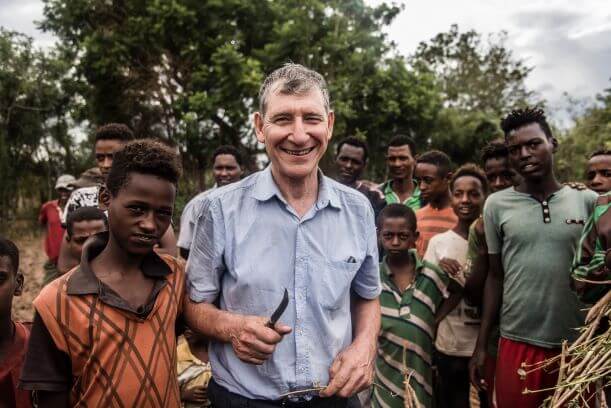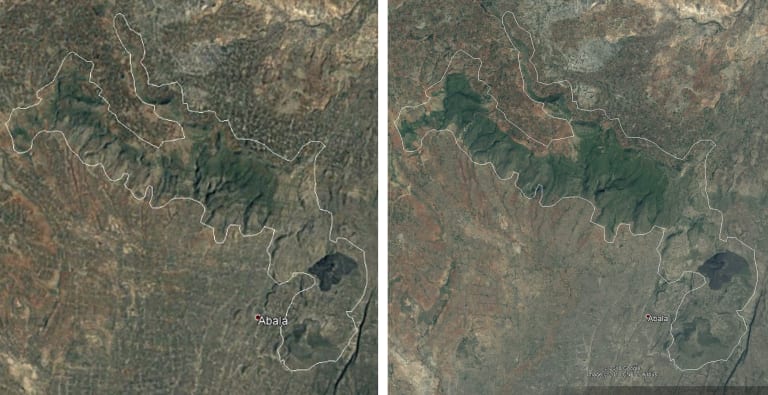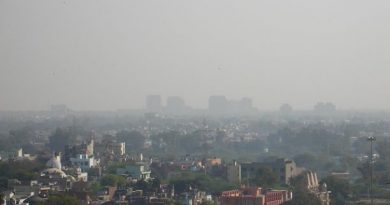From Desert to Farmland: Australian Agronomist shows way to curb desertification
Australian agronomist Tony Rinaudo, has reintroduced the ancient practise of of tree management to the Sahel in Africa that would transform communities across the globe.
 Greener Smiles to the world
Greener Smiles to the world
Tony Rinaudo will be one of four recipients this year of the Right Livelihood Award. Previous winners include US whistleblower Edward Snowden and Syria’s “White Helmets” rescue teams.
The Australian agronomist is credited with launching a tree regeneration technique called Farmer Managed Natural Regeneration that has led to reforestation of millions of hectares of degraded land in dozens of nations getting him recognition with the award dubbed the “Alternative Nobel Prize”.
Tony Rinaudo after being selected as a recipient to the award said,”For me, this award gives greater visibility and credibility to FMNR globally. Even though this simple, low cost and rapid method of reforestation has had a very significant impact on the lives of millions of people, globally it is little known to national governments, donors, implementors or front-line communities who need it the most. It is my hope that the spotlight now being shone on FMNR will accelerate a global regreening movement.”  A World Bank Study also took cognisance to FMNR through drylands research in June and said,”Crop modeling carried out for this study helped provide orders of magnitude of the benefits of FMNR in terms of reduction of drought impacts. When FMNR of native species is added to the other productivity-enhancing technologies discussed in this book, the effects are impressive. In a group of 10 countries in East and West Africa, the projected number of poor, drought-affected people living in drylands in 2030 fell—compared to the Business As Usual scenario—by 13 percent with low density tree systems and by more than 50 percent with high-density [10 trees/ha] tree systems.“
A World Bank Study also took cognisance to FMNR through drylands research in June and said,”Crop modeling carried out for this study helped provide orders of magnitude of the benefits of FMNR in terms of reduction of drought impacts. When FMNR of native species is added to the other productivity-enhancing technologies discussed in this book, the effects are impressive. In a group of 10 countries in East and West Africa, the projected number of poor, drought-affected people living in drylands in 2030 fell—compared to the Business As Usual scenario—by 13 percent with low density tree systems and by more than 50 percent with high-density [10 trees/ha] tree systems.“
Farmer-managed natural regeneration (FMNR) is the encouragement of regeneration and then the management of trees and shrubs that sprout from tree stumps, roots and seeds found in degraded soils, such as those currently in agricultural production. In other words, it counts on the inherent resilience of trees that have been given up for dead, and perhaps more importantly, the high involvement of the local communities to really make the effort work.
The ramifications are significant for how we think about FMNR and disaster risk reduction. Using FMNR to increase tree density in these dryland countries could reduce the number of people impacted by drought by 50% by 2030. “The Great Green Wall” rising in Africa from from Senegal to Djibouti are a part of a plan to thwart the southward spread of the Sahara.
The FMNR is responsible for 6 million hectares of forest being restored in Niger alone. Becoming a major weapon in the fight to stop the spread of the Sahel desert in the region. Other big successes from FMNR have come in African nations such as Senegal and Ethiopia.
In Ethiopia, where 8.2 million people are chronically food insecure coupled with 350,000 cases of acute malnutrition and 450,000 livestock deaths every year, government study, found that the FMNR-implemented areas shows resilience to Drought and El Nino weather conditions.
- income from agricultural production sales increased by more than double against neighboring districts;
- The environmental services: fodder supply, wood supply, stabilization of microclimate, hand dug wells and nutritional status of household is still intact and not affected
- The income obtained from carbon credit enabled the community to cover household expenses that include school fees, medication, improved seed purchase.
Rinaudo’s farmer-managed natural regeneration method, has restored 50,000 km2 of land with over 200 million trees in Niger alone. It has the potential to restore currently degraded drylands with an area the combined size of India. What Rinaudo has created is much more than an agricultural technique, he has inspired a farmer-led movement regreening land in the Sahel region. The news from Niger provided hope that a low-tech and low-cost approach could succeed after many years of failed tree planting efforts. Researchers crowded in and found that FMNR increased grain yields by 30%, boosted incomes, and was climate smart.

Seeing its success, the idea has been picked up elsewhere including Timor Leste, Myanmar and India.
In India, FMNR could be good news for semi arid and arid areas. The northern states are grappling with the spread of the Thar desert. Recent study by Wildlife Institute of India, says that there is a rise in number of sand storms in Delhi NCR region pointing to the desertification of Aravalli hill. The green cover which previously acted as the green barrier has lost a lot of ground to urbanisation over the years.

Experts call for immediate protection of forest cover in the Aravalis, to prevent further desertification . C C R Babu, head of Centre for Environmental Management of Degraded Ecosystems (CEMDE), department of environmental studies University of Delhi, said, “Desertification means when air becomes drier as the moisture content in air decreases. The more the air becomes drier, the occurrence of sand storms will increase. Only dense vegetation can prevent it. Vegetation produces water vapour, which leads to an increase in moisture in the air, preventing sand storms, as moist air air is heavier than dry air. In summers, Delhi-NCR always used to witness sand storms originating from the Thar desert, but the Aravalis, with a very dense forest , used to act as a physical barrier in preventing the severest sand storms from reaching here. However now that we have lost that dense forest in the Aravalis, we’re witnessing severe sand storms, which might get worse if degradation of the Aravalis continues.” Incredibly, despite every sign to the contrary, successive state governments in Haryana, the state with the largest chunk of the forests, remain in thrall to the builder lobby and worse, as they allow more and more part of the forest to be carved out, or simply by refusing to declare vital green areas as Forests. A tactic that has been picked up in the other megapolis, Mumbai, where the city’s green lung, Aarey Milk Colony and the forest it lies in, are under an unprecedented attack in the name of development on the same pretense of the area not really being a forest.
Another Study from Hamirpur University highlights that 33% of crops are failing in Rajasthan. They put Illegal mining, Human Activities, Over Population, exploitation of local vegetation and lack of adaptable vegetation as the reasons behind expansion of Thar desert.
Information and practice of FMNR in these regions coupled with proper resource management practices can greatly benefit the arid regions of the Indian subcontinent. In the last 50 years, Thar region has witnessed droughts in 23 of them. If this continues along with the expansion of the Thar which is expanding in both east and northeast directions, will spill into the southern portion of Haryana and Punjab states and into northern Gujarat state, with disastrous consequences for the agrarian economies there. In neighbouring Pakistan, the desert which covers eastern Sind province and the southeastern portion of Pakistan’s Punjab province, will further make inroads to its agricultural breadbaskets leaving more people hungry and hot.




